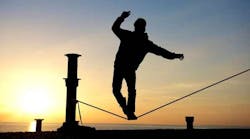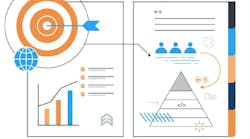Sounds odd, doesn't it? The implication is that you need to be weird to be a change agent. It's not entirely true; it's only true if you want to be an effective change agent. And you just have to be a little weird, not weird on the grand scale of things.
Why is that?
Let's conjure up a little context. Let's say your company has declared it will undertake a lean initiative and pattern itself after the Toyota Production System. As part of the initiative, the company has selected you to be one of the "change agents."
To be an effective change agent, you need to be at least a little different, if for no other reason than you are chartered to change and "take us away from the status quo." Unfortunately, the majority favor the status quo for a variety of good, bad and nonsensical reasons. This puts you in a distinct minority, which alone is reason enough for many to declare you "weird."
In addition, you are expected to exhibit curiosity and question why and how "we do some of the things we do around here." Well, "how we do things around here" is a pretty good operational definition of "our culture." Hence, you then become a person who not only questions but may even challenge the very culture of your corporation. As soon as you start to question and challenge "how we do things around here," it becomes pretty hard not to be viewed as being a little, if not really, "weird."
You then are seen as "weird" not only by the majority but also by the very people who commissioned you to be the change agent in the first place.
Effectiveness of Being Weird
This sounds like the beginning of "crazy making." And it is!
As a change agent, get ready to walk the "weirdness tightrope." I call it the "weirdness tightrope" because you are expected to be different enough to catalyze change and yet not so different as to alienate the very people who need to execute the changes. You have to be different enough to change the status quo but credible enough to connect and engage those in management and in the workforce who need to change.
Jonno Hanafin (Organization Development Network, Seasonings, Vol. 6, 2009) calls it the Perceived Weirdness Index (PWI). He says that if you are not weird enough you just get absorbed into the culture. You then are an ineffective change agent because you do not stimulate the organization enough. On the other hand, if you are too weird you are not credible and are rejected by the culture.
Hence, there is a range of weirdness that is required to be an effective change agent: weird, just not too weird. Hanafin goes on to say that on this PWI scale there is a range of effectiveness, and within that range there is a "sweet spot" of weirdness.
This sweet spot is the position of maximum effectiveness that is still accepted by the culture. It is near the upper boundary of the Effective Range on the PWI scale. Unfortunately, in the midst of a cultural change initiative, this boundary is not clear. It is not only difficult to discern the position of the boundaries, but their positions differ from situation to situation and from group to group within your culture. There are also person-to-person differences among the key decision-makers. It is a difficult task to discern and stay within the Effective Range. It is a true balancing act. It is even more difficult to find and operate at the sweet spot of maximum effectiveness.
What Will Expand the Effective Range?
Two major factors impact the width of the Effective Range of the PWI. The first is the level of desperation of the company. The more desperate your sponsor is, the more willing it is to change. If it is extremely comfortable, even if it has no right to be, the effective range of PWI for the change agent will be rather narrow. This is one reason that to effect change, John P. Kotter and others propose you create a sense of urgency or, as it is often called, a burning platform. The other way for the change agent to expand his range of effectiveness is to create a level of trust (See "Cheerleader or Lean Leader"). The most tangible way to create that trust is for there to be early successes in the change initiative. Both of these dynamics work to broaden the effective range on the PWI, which allows the change agent greater flexibility.
The Danger of Being Weird
Finding and remaining at maximum effectiveness is not only difficult, it can be dangerous for the change agent. It is optimal to operate next to the upper level of effectiveness. Unfortunately, there are severe social penalties for crossing these boundaries. Rejection of your ideas is one. The other penalty is a loss of credibility as a change agent. In the end, if it happens too often your very usefulness as a change agent will be completely undermined. If you are "just too weird," not only your ideas but also you get rejected. Hence, this sweet spot of effectiveness is also the spot of maximum uneasiness for the change agent.
The change agent who wants to take the high road and provide maximum service will strive to effect the maximum change and be near this sweet spot. At the same time, he will need to live with and manage the discomfort inherent in this risky position.
The easy way out is to be near the lower end of the effectiveness range, or even below the range of effectiveness. If you are an internal change agent, this is too often the case as you balance the risks of rejection with career choices. These career choices may include personnel actions such as appraisals and raises and ever-present perks such as bonuses and parking spots.
These options put pressure on the internal change agents. All too often, the upside and the downside of the merits of this decision cause them to see the safety of the lower end of the effectiveness scale as having much more appeal.
Likewise, it is easy for the external change agent to fall into the same trap. We (I am one of those guys) are all too aware of the reality that we are an out-of-pocket, incremental operating expense. Frequently, this is the very thing the client is trying to minimize (rather than optimize), and we can be swiftly cut from the payroll.
You need to determine if you wish to take the high road or the low road; let your conscience be your guide. The high road will give you the greatest rewards of job satisfaction and contribution. It also can give you the lowest levels of job comfort. Be ready to get uncomfortable and have both your courage and your character tested frequently. It takes all of that, and more, to be "weird enough" to walk the "weirdness tightrope" to be an effective change agent.
Lonnie Wilson has been teaching and implementing lean and other culture-changing techniques for more than 40 years. His book, "How To Implement Lean Manufacturing" was released in August 2009. Wilson is a frequent speaker at conferences and seminars. In addition to IndustryWeek, he has published articles in Quality Digest and was a frequent contributor to iSixSigma magazine. His manufacturing experience spans 20 years with Chevron, where he held a number of management positions. In 1990 he founded Quality Consultants, www.qc-ep.com, which teaches and applies lean and other culture-changing techniques to small entrepreneurs and Fortune 500 firms, principally in the United States, Mexico and Canada. In particular, he specializes in "lean revitalizations," assisting firms that have failed or failing lean implementations and want to "do it right." In his not-so-spare time, Wilson is the men's varsity soccer coach at Cathedral High School in El Paso, Texas. You can e-mail Lonnie Wilson at [email protected].
See Also:




